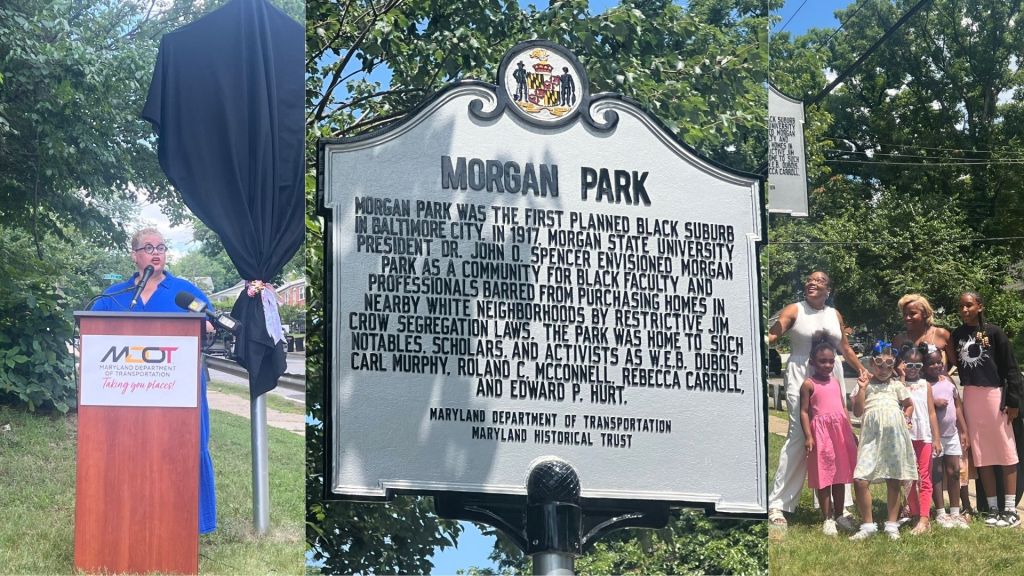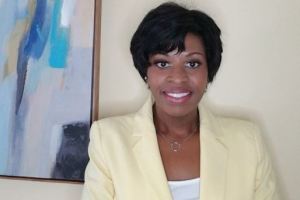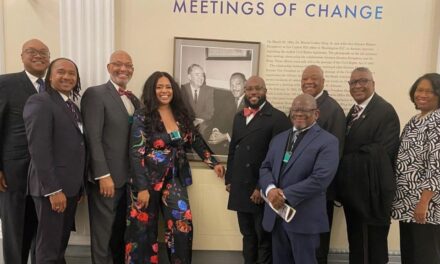By Tierra Stone
AFRO Intern
tierrastone@afro.com
Residents of the historically Black Morgan Park neighborhood in Northeast Baltimore came together on June 12 to officially unveil a historical marker in honor of the area and the legendary leaders who called the community “home.”

Photo Credit: AFRO Photo / Tierra Stone
The official historical marker of Morgan Park is unveiled with details on the history of the neighborhood and famous former residents, such as W.E.B. Dubois and the late AFRO Publisher Dr. Carl J. Murphy.
Jawauna Greene, assistant secretary of the Maryland Department of Transportation, stands with Morgan Park youth (left to right): Zara Brown; Kennedy Rose Jackson; Erin Epps; Jessica Jackson, board member for the Morgan Park Improvement Association, and Madison Morgan.
Photo Credit: AFRO Photo / Tierra Stone
The Morgan Park neighborhood, founded in 1917, has been a jewel in the crown of Charm City for more than a century, evolving over time.
Juwauna Greene, assistant secretary for the Maryland Department of Transportation, spoke with the AFRO on what the historical marker meant for the community, which was the first suburb to be designed and planned for African Americans in Baltimore City.
“This is important because it stands as a living, breathing, testament. When people walk by and they’re living their daily lives they get to see this,” said Greene. “They get to see that marker, and they’ll stop for a moment, and say ‘I’m standing on some sacred ground.”
Raquel Simpson, chair of the Morgan Park Improvement Association History Committee, shared what she loves about living in the community.
“I moved here in December 2016 and when I moved in I felt right at home,” she said. “People embraced me and my family. I always felt at home and I always felt welcome. We’re still trying to preserve that in our neighborhood.”
Though Simpson was welcomed with open arms, that hasn’t always been the case.
At one point, Jim Crow laws prohibited African Americans from sharing spaces with White people in Maryland. This included schools, restaurants and neighborhoods. Subsequently, Baltimore was responsible for writing the first housing segregation laws.
The Maryland Center for History and Culture reports that “one of the first official policies was Baltimore City Ordinance 610, known as the ‘West plan’ – named after councilman Samuel West. This ordinance, passed by the city of Baltimore in December of 1910, stated that no Black resident could move onto a block in which more than half of the residents were White and vice versa.”
According to “The History of Morgan Park” by Roland C. McConnell and “The City as Suburb,” by Eric L. Holcomb, when Morgan College, now Morgan State University, moved to its current location in Northeast Baltimore, the parcel of land designated for the school included Morgan Park.
“Seventy acres were proposed to relocate Morgan from West Baltimore. Part of the acreage included Morgan Park, a small thirteen acre development attached to Morgan College, that would also accommodate faculty and staff,” reads information from The Gazelle, a hyperlocal publication printed by the Morgan Park Improvement Association.
Leonore Burts, longtime resident of the Morgan Park Community, spoke on how White residents of Baltimore time and time again challenged the relocation of the school, and thus, Morgan Park.
“We had three court cases with people from the neighborhood nearby who didn’t want Blacks to move in because of all of the press about how we would bring down the neighborhood and everything negative,” she said.
Ultimately, Morgan College leadership was successful in securing land for the institution and the residential area known as Morgan Park. The area was home to W. E.B. Dubois, the first African- American man to earn a Ph.D from Harvard University, Dr. Regina Goff, the first African-American assistant commissioner in the United States Office of Education under the Department of Health, Education and Warfare and AFRO Publisher Dr. Carl J. Murphy. Through the years, the Morgan Park Improvement Association has strived to upkeep the idyllic charm of the community, while also preserving its rich history.
Valencia Baker, president of the Morgan Park Improvement Association spoke with the AFRO about the history of the neighborhood and credits Burts for her work regarding the marker.
“Leonore Burts, who lives in the Du Bois house, is the person who coordinated that effort for us. She did all of the leg work and all of the writing to get us established,” said Baker.
Burts said there were multiple steps in how the marker came to be.
“I applied for a grant for us to pay someone to write our nomination because it’s a 70 to 100 page document and it has all these requirements for photographs and for the significance of the neighborhood. The person that we hired is the one that provided all of the documentation,” she said.
Burts also explained that the process took about three years before it reached completion.
According to the Maryland Department of Transportation (MDOT) “Maryland has installed cast metal Historical Markers along state roads signs since 1930. Approximately 800 Historical Markers have been installed since 1930 and around 780 remain today.”
Simpson said the day of the marker unveiling was a special one.
“Having that sense of community where we get to socialize with each other and finding out about our history brings me joy,” Simpson said.
Throughout the celebration there were many speakers to commemorate the day Kim McCalla, vice president of Design and Construction at Morgan State University, Tonya Miller, senior advisor of Arts and Culture for the Baltimore City Mayor’s office and a representative from state senator Mary Washington’s (D-MD-43).
As the ceremony came to a close Baker shared the importance of the marker and what it meant to preserve the history of the neighborhood.
“It is a call to action,” said Baker. “It is a call to action for us to cherish and protect our history.”
Burts agreed and shared why it’s important to preserve this history for the future generations.
“You have to know that you have a legacy, you gotta respect it and then learn everything you can about it. The last and more important thing is to preserve it for future generations.”
The post Morgan Park, one of Baltimore’s oldest african-american neighborhoods receives its official historical marker. appeared first on AFRO American Newspapers.










